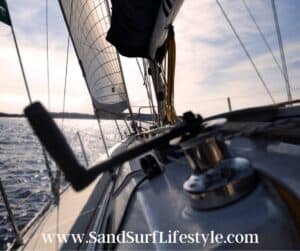 Leaving behind the stress of daily life, sailing provides a carefree feeling that is not available in many other settings. Capturing the wind and letting your sails carry you away is one of the glories of nautical adventures. Knowing how to best harness the wind and soar along on the water will let you feel that exhilaration.
Leaving behind the stress of daily life, sailing provides a carefree feeling that is not available in many other settings. Capturing the wind and letting your sails carry you away is one of the glories of nautical adventures. Knowing how to best harness the wind and soar along on the water will let you feel that exhilaration.
Sailing provides an incredible challenge and wondrous enjoyment. Continue reading for information on points of sail and their impact on your water ventures. Grab your gear and hop on board.
What Is a Beam Reach?
Nautically defined, the beam of a boat is your boat’s width. The measurement is taken at the widest part of your boat. When a boat is on a reach, the wind is blowing to the side of the vessel. A point of sail is referring to your boat’s course in relation to the wind.
In a beam reach, the wind is moving across the widest part of the boat, which is the center of the boat. Your sail is perpendicular to the wind direction regardless if the wind is coming from the port or starboard side. Therefore, the wind travels at a right angle or 90-degree angle to your sail. More surface area of your sail is available to catch the wind.
Your sail is shaped by the airflow. This creates a mix of high and low pressure that interacts to propel your boat forward. An ideal equilibrium of wind is formed, which is why a beam reach is such an enjoyable sailing state.
Wind moving across your boat generates a lift effect. With lift, you can increase speed. When sailing at a right angle to the wind, you do not need to fight the wind. The wind hits the beam of the boat directly. Because of the direction of the wind to the boat, you are sailing forward. The boat is not going upwind or downwind. To attain high speeds, resistance must be low.
This is why beam reach can be the fastest point of sail.
Not sure what the Difference Between a Ketch and a Schooner is? Find out here.
What Are the Other Points of Sail?
Picture your sailboat encircled by water. Remember back to math class. Circles have a circumference of 360 degrees. For sailing, our circle will now be cut into sections. Each section is a point of sail, which is a boat’s angle compared to the direction of the wind.
For comparison and visualization, we will equate the points of sail to a compass. Use an approximate 45-degrees for each point of sail whether it is on the eastern or western side of the imaginary compass.
No Sail or No Go Zone:
Envision the wind coming directly from the north. This is the no sail zone. The area for the no go zone is 45-degrees on either side of the wind. From our complete compass circle, we will subtract 90-degrees, leaving 270-degrees for the other point of sail zones.
Since sailboats cannot sail directly into the wind, this section of our circle is called the no-sail or no go zone. If you attempt to sail into the wind, your sails will flap or droop. This occurs because there is not any wind to catch your sails since you sailed into the wind.
Your boat will be stagnant or as commonly referred to – being in irons. Legend has it that being in irons is a term that refers way back to the old sailing days. In sailing days of long ago, criminals were on board. When the criminals were not performing a task, they were restrained or in irons. The term transferred its usage to boats themselves when they are constrained by a lack of wind.

- Close Hauled
At either edge of no-sail zone, there are two close-hauled courses that a sailboat may travel. Continuing with the compass, these two zones would be northeast and northwest. Both of the close-hauled angles are sailing routes that take you as close to the direction of the true wind as possible for sailboats.
When sailing in these paths, your sails are hauled as close to the boat’s centerline as feasible. This means your sails are tightly pulled in. This can be a challenging route to sail. However, if your journey’s end is to where the wind is blowing from, you will need to be in this section of sail zones. Traveling in a zig-zag pattern is one approach to reaching your destination.
- Close Reach
Continuing southward on our compass analogy, the next point of sail is called close reach. This is located between close-hauled and beam reach. Similar to sailing in beam reach, this is an enjoyable direction to sail in. The wind has many of the same attributes.
Since you are on a reach, the wind is coming from the side. Pressure on the inside and outside of your sails is still creating lift. Your sails are not completely perpendicular as in the beam reach, but you will still be able to garner speed in this zone.
- Beam Reach
Furthering the compass visualization, the beam reach is directly east and west. Therefore, the wind is at a 90-degree angle to the sail. Details of the beam reach are presented in another section of this article.
- Broad Reach
On the compass, the broad reach zones will be in the southeast and southwest sections. The direction of the wind shifts in this area; you are now starting to sailing downwind. Your sails do not have the lift they had in close reach and beam reach. Now, your sails will be pushed by the wind.
You are about 135-degrees from the true wind. Wind blowing over the boat between the beam and stern will necessitate trimming your sails. Though you are still in a reach, it will not have the same speed you find in a close reach or beam reach.
- Running
In this last point of sail, running is the southern point of the compass. You are 180-degrees from the no sail zone. This means that you are directly across from the origination of the wind. When you are sailing is this angle, you are downwind. This means that the power of wind is directly behind you. This is a challenging area in which to sail.
For experienced sailors, many love the excitement that can be found with the wind at your back. While sailing downwind sounds and is thrilling, remember the wind can change course. If the wind suddenly shifts on you, you will need to react quickly to avoid any issues. This angle of sail can offer the least predictability.
Why Is the Wind So Important?
 Sailboats are dependent upon the wind for their power. The direction of the wind determines the course of your sailboat. Wind can push and pull your boat. To control your boat, sailors must know the direction of the wind. In addition, sailors need to understand the wind angle in relationship to their boat. This is vital so you know how and when to trim your sails.
Sailboats are dependent upon the wind for their power. The direction of the wind determines the course of your sailboat. Wind can push and pull your boat. To control your boat, sailors must know the direction of the wind. In addition, sailors need to understand the wind angle in relationship to their boat. This is vital so you know how and when to trim your sails.
Lift and drag determine which point of sail is fastest or how to increase your speed in any angle of sail. The more lift you have; the faster you go. Lift is the force that drives the sails. When the wind or air moves over both sides of the sail, lift is created. Drag is the opposite of lift. When you have a lot of drag, your sailing time will be slower.
The captain of the ship must know how to utilize the wind and the boat’s sails for the sailboat to move. Without wind in the sails, the boat is just floating or in a state of neutral.
Sailors recognize that the key to an incredible sailing experience is understanding the wind and waves and their interactions. Capturing the interaction of both the wind and waves lets a sailor control their journey.
Please note: This blog post is for educational purposes only and does not constitute legal or medical advice. Please consult a legal expert or medical professional to address your specific needs.

